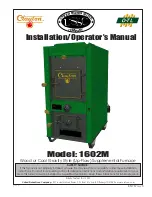
Page 19
LRP14AC / LRP14HP
Condensate Drain
This package unit is equipped with a 3/4” FPT coupling
for condensate line connection. Plumbing must conform
to local codes. Use a sealing compound on male pipe
threads.
Do not
operate unit without a drain trap. The condensate
drain is on the negative pressure side of the blower;
therefore, air being pulled through the condensate line will
prevent positive drainage without a proper trap.
The condensate drain line must be properly trapped,
routed to a suitable drain and primed prior to unit
commissioning.
NOTE
:
Install drain lines and trap so they do not block
service access to the unit.
See Figure 5 for proper drain arrangement. The drain line
must pitch to an open drain or pump to prevent clogging
of the line. Seal around the drain connection with suitable
material to prevent air leakage into the return air system.
To prime trap, pour several quarts of water into drain,
enough to fill drain trap and line.
Drain lines should be hand-tightened only. Do not use
tools to tighten fitting into drain.
CAUTION
Minimum Pitch:
1 in (25) Per 10”
(3048 mm) of
Line
Open
Vent
Unit
Trap must be deep enough to offset maximum static difference
(generally, 3 inches (76 mm) minimum). In addition, the drain line
must be supported if longer than 10 feet.
Trap must be primed at start-up.
Mounting
Frame
Figure 9. Typical Condensate Drain Connection
Crankcase Heater (if used)
Some models may be equipped with a crankcase heater
to prevent excessive migration of liquid refrigerant into the
compressor during off cycles. Power must be maintained
to the unit to keep this feature active.
Except as required for safety while servicing,
do not open
the system disconnect switch.
Heater Kit Accessory (if used)
The unit is fully equipped for cooling operation without
auxiliary heat. A heater kit accessory may also be used. To
install the heater kit accessory (see Figure 7):
1. Disconnect the power and open the main control
access.
2. Disconnect the plug separating the high voltage wire
harness. Remove the high voltage wire harness plug
and discard.
3.
Remove the heater blockoff by removing the four
screws holding it in place.
4. Insert the heater into the control panel and fasten in
the same mounting holes.
5. Plug the heater wiring harness into the wire harness
on the control assembly. Field wiring of the auxiliary
heater is separate from the unit power supply. Wire the
power supply wiring for the heater to the appropriate
connections on the heater kit.
Sequence of Operation
Cooling
When the thermostat is in the cooling mode, the O circuit
is powered, which energizes the reversing valve. Upon
cooling demand, the thermostat closes circuit R and Y.
Closing R and Y closes the unit contactor, starting the
compressor and outdoor fan. The thermostat automatically
closes the R to G circuit, which brings on the indoor blower
at the same time. Upon satisfying cooling demand, the
thermostat will open the above circuits and open the main
contactor, stopping the compressor and outdoor fan. If the
unit is equipped with a delay timer, the blower will continue
to operate for 60 to 90 seconds, which improves system
efficiency.
Heating - Heat Pump Stage
Upon heating demand, the thermostat closes circuit R to
Y, which closes the unit contactor, starting the compressor
and outdoor fan. The reversing valve is not energized in
the heating mode. The thermostat again automatically
brings on the indoor fan at the same time. Upon satisfying
heating demand, the thermostat opens above circuits and
stops unit operation.
Heating - Auxiliary Electric Heat
Upon heating demand for auxiliary electric heat, the
thermostat closes circuit R to W, which energizes the































![Roberts Gorden Combat UHD[S] 150-400 Specifications preview](http://thumbs.mh-extra.com/thumbs/roberts-gorden/combat-uhd-s-150-400/combat-uhd-s-150-400_specifications_1469644-1.webp)







